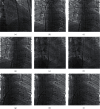Study on the Curative Effect and Safety of Radiofrequency Catheter Ablation of Paroxysmal Atrial Fibrillation via Zero-Fluoroscopy Transseptal Puncture under the Dual Guidance of Electroanatomical Mapping and Intracardiac Echocardiography
- PMID: 34123417
- PMCID: PMC8166467
- DOI: 10.1155/2021/5561574
Study on the Curative Effect and Safety of Radiofrequency Catheter Ablation of Paroxysmal Atrial Fibrillation via Zero-Fluoroscopy Transseptal Puncture under the Dual Guidance of Electroanatomical Mapping and Intracardiac Echocardiography
Abstract
Aims: 3D electroanatomical mapping combined with intracardiac echocardiography- (EAM-ICE-) guided transseptal puncture has been proven safe and effective during the radiofrequency catheter ablation (RFCA) procedure used to treat paroxysmal atrial fibrillation (PAF). In this study, we aimed to compare the curative effect and safety of RFCA via F (fluoroscopy) and zero-fluoroscopy transseptal puncture guided by EAM-ICE in patients with PAF.
Methods and results: A prospective study in which 110 patients with PAF were included and assigned to two groups was conducted. Fifty-five (50%) patients were enrolled in the EAM-ICE group, whereas the other 55 (50%) patients were enrolled in the F group. There were no significant differences in baseline characteristics between the two groups. The transseptal duration time was longer in the EAM-ICE group (19.8 ± 3.0 min vs. 8.6 ± 1.2 min, p ≤ 0.01); however, fluoroscopy was not used in the EAM-ICE group compared with the F group (0 mGy vs. 109.1 ± 57.9 mGy). Similarly, there was also no significant difference in the recurrence rate of atrial fibrillation between the EAM-ICE and F groups (25.5% vs. 18.2%, p=0.356).
Conclusion: RFCA via EAM-ICE-guided zero-fluoroscopy transseptal puncture in patients with PAF is safe and effective for long-term follow-up.
Copyright © 2021 Fei Hang et al.
Conflict of interest statement
The authors declare that they have no conflicts of interest.
Figures





Similar articles
-
Zero-fluoroscopy transseptal puncture guided by right atrial electroanatomical mapping combined with intracardiac echocardiography: A single-center experience.Clin Cardiol. 2020 Sep;43(9):1009-1016. doi: 10.1002/clc.23401. Epub 2020 Jun 7. Clin Cardiol. 2020. PMID: 32506504 Free PMC article. Clinical Trial.
-
Catheter ablation of atrial fibrillation without the use of fluoroscopy.Heart Rhythm. 2010 Nov;7(11):1644-53. doi: 10.1016/j.hrthm.2010.07.011. Epub 2010 Jul 14. Heart Rhythm. 2010. PMID: 20637313 Clinical Trial.
-
Reduction of radiation exposure during atrial fibrillation ablation using a novel fluoroscopy image integrated 3-dimensional electroanatomic mapping system: A prospective, randomized, single-blind, and controlled study.Heart Rhythm. 2015 Sep;12(9):1945-55. doi: 10.1016/j.hrthm.2015.05.018. Epub 2015 May 19. Heart Rhythm. 2015. PMID: 26001508 Clinical Trial.
-
The use of Intracardiac Echocardiography in Catheter Ablation of Atrial Fibrillation.Curr Cardiol Rep. 2024 Sep;26(9):893-901. doi: 10.1007/s11886-024-02091-w. Epub 2024 Jul 12. Curr Cardiol Rep. 2024. PMID: 38995505 Review.
-
Role of Intracardiac echocardiography in Atrial Fibrillation Ablation.J Atr Fibrillation. 2013 Apr 6;5(6):786. doi: 10.4022/jafib.786. eCollection 2013 Apr-May. J Atr Fibrillation. 2013. PMID: 28496830 Free PMC article. Review.
Cited by
-
Comparison of safety and effectiveness of different sheaths in ablation of focal atrial tachycardia: a retrospective study.J Thorac Dis. 2024 Mar 29;16(3):2011-2018. doi: 10.21037/jtd-24-52. Epub 2024 Mar 27. J Thorac Dis. 2024. PMID: 38617770 Free PMC article.
-
Impact of Systematic Use of Intracardiac Ultrasound during Transseptal Catheterization in the Electrophysiology Laboratory.J Cardiovasc Dev Dis. 2023 Feb 2;10(2):62. doi: 10.3390/jcdd10020062. J Cardiovasc Dev Dis. 2023. PMID: 36826558 Free PMC article.
References
LinkOut - more resources
Full Text Sources
Medical
